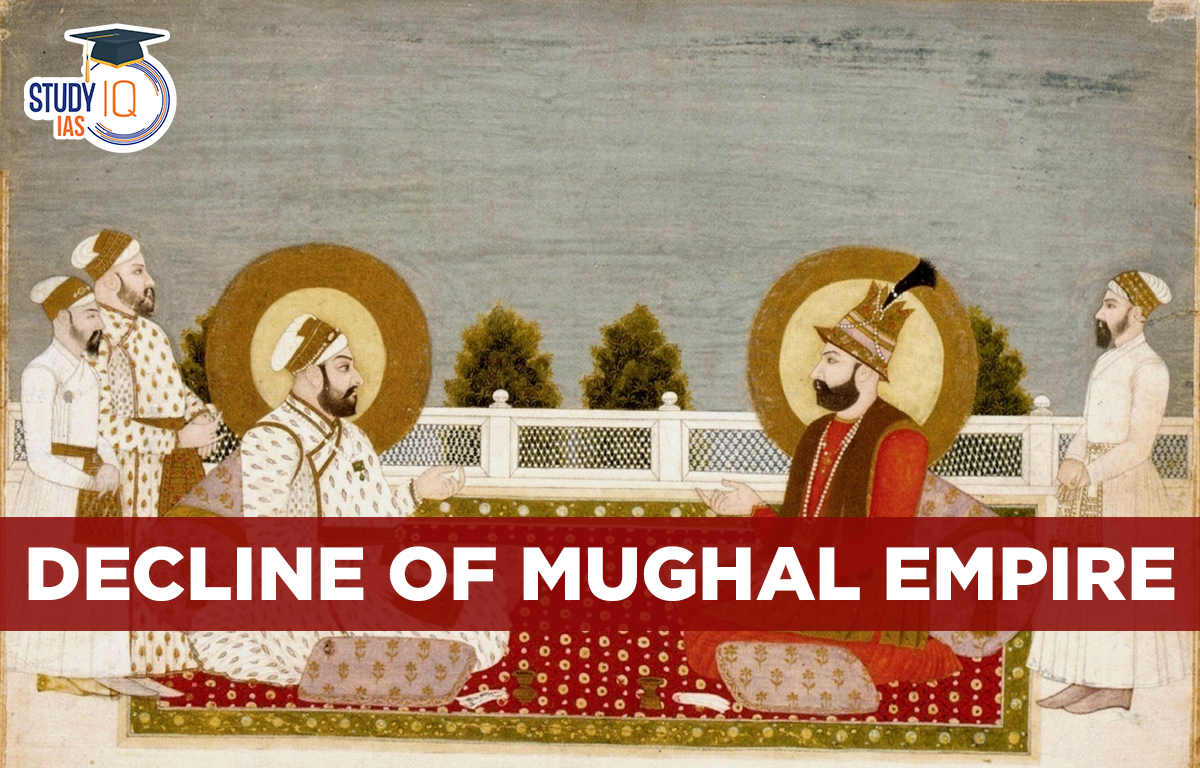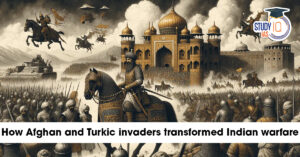Table of Contents
Decline of Mughal Empire
Read all about Decline of Mughal Empire. The Successor States emerged in its stead after the Mughal Empire disintegrated in the 1750s. The Mughals enjoyed direct rule over nearly all of India until 1707. When Aurangzeb passed away in 1707 CE, the Mughal Empire swiftly started to disintegrate.
The Great Mughals’ rule, also known as the Later Mughals, began in this year, which is typically used to set them apart from the smaller Mughals. You can use this page to learn more about the decline of the Mughal Empire as you study modern Indian history for the UPSC Civil Service Exam.
Decline of Mughal Empire History
Early modern South Asian Empire the Mughal Empire, also referred to as the Mughal Empire. The empire lasted for two centuries, extending from Kashmir in the north to the highlands of modern-day Assam and Bangladesh in the east, and from the western margins of the Indus basin to the Deccan plateau uplands in south India.
Babur defeated Ibrahim Lodi in the first battle of Panipat, and he later established the Mughal Empire. Thus, a new era and empire began in India, lasting for more than three centuries, from 1526 to 1857. Six famous kings of this dynasty known as the “Great Mughals,” Babur, Humayun, Akbar, Jahangir, Shah Jahan, and Aurangzeb, left their imprint on Indian history.
As the European presence in the Indian Ocean increased and the demand for raw and finished Indian goods increased, the Mughal courts became increasingly wealthier. The Mughal nobles spent more extravagantly, which led to increased support for art, literature, textiles, and architecture, especially under Shah Jahan’s administration. Following Aurangzeb’s passing in 1707, the empire started to fall apart.
Decline of Mughal Empire Cause
1. Aurangzeb’s Religious Regulations
The Deccan and religious policies of Aurangzeb contributed to the fall of the empire. The Mughal administration was pushed to its breaking point by the attempt to extend its control over Golconda, Bijapur, and Karnataka.
Additionally, it made Mughal nobility in the region unable to collect their debts from the jagirs given to them, pushing them to enter into covert agreements with the Marathas. It also left Mughal lines of communication open to Maratha attacks. His repeated disregard for the religious sensibilities of his non-Muslim people, the declaration of a policy that led to the destruction of several temples and the reinstatement of jizya.
This alienated Hindus and increased the position of those who opposed the Mughal Empire for political or other reasons, alienating Hindus and strengthening the position of those who opposed the Mughal Empire for political or other reasons. The successors to Aurangzeb were ineffective and unable to adequately maintain the government.
2. Influence of Nobles
The majority of them served as pawns for powerful aristocrats. The empire ultimately suffered harm from the Delhi-based succession conflict that lasted from 1707 to 1719 CE. After Aurangzeb’s death, the nobility assumed a significant amount of power, and their personal interests determined the course of politics and administrative activity.
The four aristocratic groups that made up the Mughal court were the Turanis, Iranis, Afghans, and Muslims who were natives of India. These factions were always squabbling for jagirs, high positions, and power, which ultimately led to the fall of the empire. The creation of multiple independent countries decreased tax revenue, and continued conflicts severely depleted the budget.
3. Ineffective Army
The royal budget also suffered as a result of Ahmad Shah Abdali’s and Nadir Shah’s foreign incursions. The Mughal army gradually got demoralised and ineffective after losing numerous battles. The Mughals paid a heavy price for their contempt for naval supremacy.
The Mughal Empire’s chances of existence were put to death by the arrival of the British and other European colonial forces in India. Western colonial powers were politically aware of Indian realities and had greater military and financial resources.
4. Rise of Regional Aspirations
Under Aurangzeb’s dominion, ethnic groups including the Jats, Sikhs, and Marathas rose up in resistance. They contested the Mughal state’s dominance in an effort to found their own kingdoms. Despite their failure, they had an impact on how political events would develop in the future in their respective regions. Their ongoing struggle for political supremacy with the subsequent mughals seriously hurt the empire.
In an effort to keep the Rajputs under control, Bahadur Shah I and later Aurangzeb encouraged them to rebel against the Mughals. Later Mughals tried to pursue a policy of reconciliation with the Rajputs, but it was too late; the Rajputs had lost faith in the Mughals and were unwilling to work with them for the benefit of the empire.
The Marathas were proving to be a difficult opponent as well. Their initial objective was to retake control of the Maharashtra region, but it swiftly grew to include securing the Mughal Emperor’s legal consent to gather sardeshmukhi and chauth throughout India.
By 1740, they had taken control of the provinces of Gujarat, Malwa, and Bundelkhand after pushing further north. The Marathas’ rising ambition and might, along with the Rajputs’ war against the empire, diminished Mughal power.
5. Economic and Administrative Problems
Over time, the number of amirs and their ranks, or mansabs, had increased significantly, and there was little more land left to be divided among them as jagirs. By showing higher revenue from the jagirs on record, Aurangzeb aimed to ameliorate the severe shortage of jagirs or bejagiri.
This was a hasty solution because the amirs tried to use the peasantry as leverage to get back the reported money from their jagirs. The result was conflict between the amirs and the peasants. Battles, the opulent lifestyles of the emperors and amirs, and the defeat in Khalisa Land were further factors that had a negative impact on the state.
The state’s expenses therefore far surpassed its income. Furthermore, there were no significant advances in science or technology that may have boosted a weak economy. The once-vibrant trade did not increase the empire’s finances, even when European traders advanced alongside coastal India. These administrative and financial problems only got worse after Aurangzeb’s passing.
The empire had grown too enormous to be efficiently managed by a centralised government while the emperors were weak and incompetent.
6. The Advent of the British
The Mughal Empire had no chance of surviving with the establishment of the British and other European colonial powers and their arrival in India. Western colonial powers were more powerful militarily, financially, and politically than their Indian counterparts.
Decline of Mughal Empire UPSC
Around 1707 CE, when Aurangzeb passed away, the Mughal Empire started to fall apart swiftly. Typically, this year is used to set the Great Mughal Empire apart from the lesser Mughal Empire, sometimes known as the Later Mughals. Issues in society, the economy, politics, and institutions all played a part in the fall of the Mughal Empire.
The East India Company started to serve the British government in 1813 after the government had divested it of its monopolistic power. The last king, Bahadur Shah II, was exiled after the Indian Rebellion in 1857, which led the British colonial government to gain power and take over the Indian subcontinent. The Decline of the Mughal Empire is fully explained in this article for the UPSC Exam.


 Birsa Munda Birth Anniversary 2025: Life...
Birsa Munda Birth Anniversary 2025: Life...
 Military Innovations of Afghans and Turk...
Military Innovations of Afghans and Turk...
 Self-Respect Movement, History, Objectiv...
Self-Respect Movement, History, Objectiv...

























